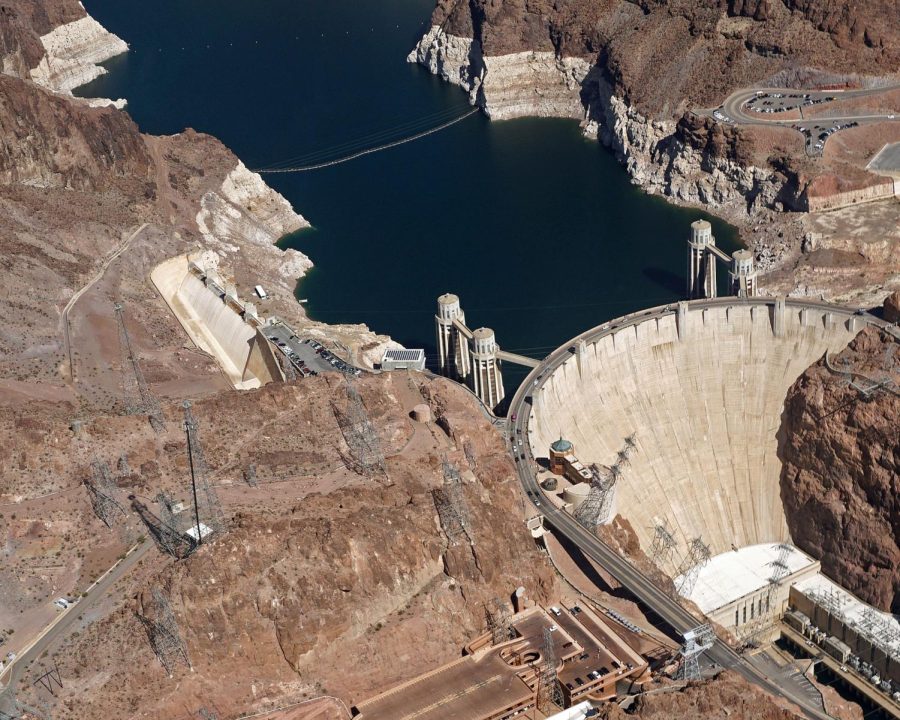The Good, the Bad—and the cautious optimism of the Colorado River Deal
Possible pros and cons of the Colorado River Deal: Implications for Arizona
Aerial view of Hoover Dam
May 26, 2023
An agreement was reached on May 22nd between three Southwest states, including Arizona, to cut billions of gallons of Colorado River water usage over the next four years. The proposed deal, which involves California, Arizona, and Nevada, aims to conserve a substantial portion of river water in exchange for over $1 billion in federal funds.
As part of the agreement, the states involved have proposed to conserve a certain amount of their river water allocation over a specific period. The idea behind the deal is that the states would voluntarily forgo using a portion of their allocated water in exchange for financial compensation from the federal government.
While the agreement has the potential to address the water crisis on the Colorado and protect vital resources, it also raises questions regarding the implications the agreement will have on our state.
Arizona state and tribal leaders, including Gov. Katie Hobbs, held a news conference on May 25th to provide additional information on the agreement.
“What it’ll do (the agreement) for Arizona, and for the country as a whole, cannot be understated, this decisive action will provide immediate relief.” Gov. Hobbs said.
The Governor also noted that the states were able to successfully negotiate a deal before federal powers would have stepped in to control the ongoing crisis on the Colorado.
“Without this partnership the federal government would have forced drastic cuts to Arizona’s water use. Instead, we successfully negotiated voluntary conservation efforts, allowing states, cities and farmers to have a say in their water future. No Arizonan will be forced to reduce their water use,” Hobbs said.
While there are still unresolved issues that need to be addressed before the deal can be finalized, the governor ensured the agreement was in the state’s best interest.
Here are some key points regarding the agreement and some potential pros and cons for Arizona moving forward.
Possible Pros:
*Water Conservation: The agreement emphasizes voluntary water conservation, which can help address the ongoing drought and water scarcity issues in the Southwest. By reducing water usage, states can contribute to the long-term sustainability of the Colorado River, ensuring a more reliable water supply for its residents, agriculture, and industries.
*Federal Funding: Arizona stands to benefit from the substantial federal funds allocated for conservation efforts. The $1 billion in federal funds can be used to invest in infrastructure improvements, such as upgrading irrigation systems and implementing water-efficient technologies. These investments can enhance water management capabilities in the state and support sustainable water practices.
*Protection of Reservoirs: The deal aims to protect the nation’s largest reservoirs, including Lake Mead, which is crucial for Arizona’s water supply. Conserving water and maintaining adequate levels in these reservoirs can help mitigate the risk of water shortages and ensure reliable access to drinking water and hydropower for millions of people in the region.
Possible Cons:
*Compensation Disputes and Federal Involvement: One of the challenges in finalizing the deal lies in determining the federal compensation amounts for water conservation efforts. While federal funds will pay for the majority of the conservation efforts, the parties are negotiating how much of those savings should go uncompensated. Additionally, the states are raising concerns about the federal government’s ongoing environmental review process, which aims to revise the rules governing operations at Lake Powell and Lake Mead.
*Disrupted Water Supply: The implementation of water conservation measures and potential reductions in water allocations could disrupt the water supply for various communities and industries in Arizona. This could lead to increased water scarcity and potentially impact residents, businesses, and agricultural operations that rely on a stable and sufficient water supply. The uncertainty surrounding future water availability may create challenges in planning and resource management.
*Balancing Priorities: Arizona, like other states in the Lower Basin, face the challenge of striking a balance between water rights, federal authority, and long-term sustainability. The negotiations involve discussions on enhanced federal authority and potential emergency cuts in water allocations, this rings an alarm for some. Increased federal authority could have implications for Arizona’s water usage and agricultural regions. Ensuring that the deal respects existing water rights while effectively managing the water supply is a delicate task.
Interior Sec. Deb Haaland said in a statement that the deal was a “testament” to the Biden administration’s “commitment to working with states, Tribes and communities throughout the West to find consensus solutions in the face of climate change and sustained drought.”
Reportedly, President Joe Biden applauded the deal in a statement, saying, “the agreement “marks an important step forward in our efforts to protect the stability of the Colorado River System in the face of climate change and historic drought conditions.”


